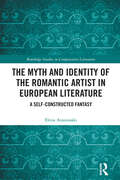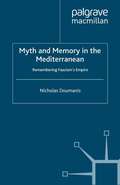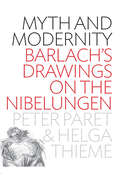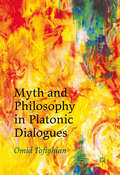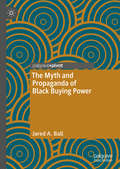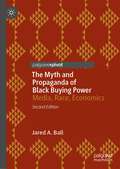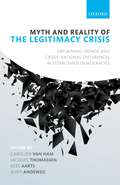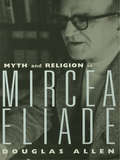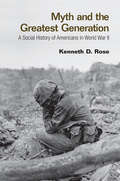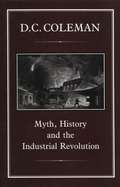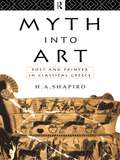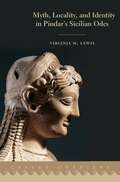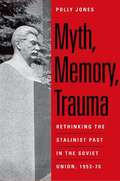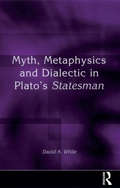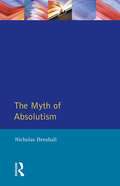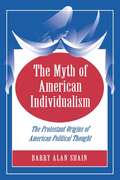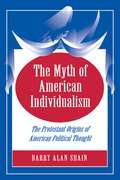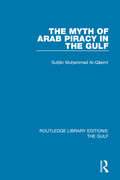- Table View
- List View
The Myth and Identity of the Romantic Artist in European Literature: A Self-Constructed Fantasy (Routledge Studies in Comparative Literature)
by Elena AnastasakiThis study addresses the question of artistic identity and the myth of the artist as it has been shaped by the artists themselves. While the term artist is to be understood in a broad sense, the focus of this study is the literature of the Romantic tradition. Identity is largely perceived as a construct, and a central hypothesis of this book concerns its aesthetic value and the ways it creates dominant narratives of self-perception that produce powerful myths. The construction of the artist’s identity, be it collective or personal, rests on a series of aesthetic praxes. Caught between the mythic idealisation of poetic genius and its social devaluation, the Romantic artist seeks to create a place for himself, and in doing so, he engages in his own mythmaking. This process is studied in an interdisciplinary perspective, approaching texts and writers from different traditions. The study analyses various typologies of the artist, numerous mythmaking strategies as well as several postural techniques; all of which have sketched major direct or indirect fictional self-portraits in the European tradition.
Myth and Memory in the Mediterranean: Remembering Fascism's Empire
by N. DoumanisThis book examines the relationship between coloniser and colonised among the Italian-held Dodecanese Islands between 1912 and 1943, and is based on an oral history project conducted between 1990 and 1995. Italian power is described as having been negotiated, resisted and modified by locals, who admired many aspects of Italian rule without according the regime any legitimacy. This ethnographic history challenges standard views on Italian colonialism and Greek nationalism, and reflects on contemporary questions regarding historical memory, political culture and social identity.
Myth and Modernity: Barlach's Drawings on the Nibelungen (Berghahn Ser.)
by Peter Paret Helga ThiemeIn interpreting its own age art often turns to the past. At the beginning of the twentieth century one of these encounters between present and past was prompted by the interest a major figure in German modernism, the sculptor Ernst Barlach, came to take in the medieval epic The Song of the Nibelungen. There exists no statement by Barlach to explain what prompted his interest and the resulting sequence of large drawings on the epic’s climactic final segment, reproduced here. In conception and execution these drawings stand out in Barlach’s graphic oeuvre, as they stand apart from the multitude of interpretations the Nibelungen inspired in art, literature, and music. This book discusses the epic and its course through German history, the artist’s biography and the course of his work, as well as the place the drawings occupy in the art, culture, and politics of Germany in the 1920s and 30s and beyond to the ideological and political crises of Central Europe before and after the First World War.
Myth and Philosophy in Platonic Dialogues
by Omid TofighianThis book rethinks Plato’s creation and use of myth by drawing on theories and methods from myth studies, religious studies, literary theory and related fields. Individual myths function differently depending on cultural practice, religious context or literary tradition, and this interdisciplinary study merges new perspectives in Plato studies with recent scholarship and theories pertaining to myth. Significant overlaps exist between prominent modern theories of myth and attitudes and approaches in studies of Plato’s myths. Considering recent developments in myth studies, this book asks new questions about the evaluation of myth in Plato. Its appreciation of the historical conditions shaping and directing the study of Plato’s myths opens deeper philosophical questions about the relationship between philosophy and myth and the relevance of myth studies to philosophical debates. It also extends the discussion to address philosophical questions and perspectives on the distinction between argument and narrative.
The Myth and Propaganda of Black Buying Power
by Jared A. BallThis Palgrave Pivot offers a history of and proof against claims of "buying power" and the impact this myth has had on understanding media, race, class and economics in the United States. For generations Black people have been told they have what is now said to be more than one trillion dollars of "buying power," and this book argues that commentators have misused this claim largely to blame Black communities for their own poverty based on squandered economic opportunity. This book exposes the claim as both a marketing strategy and myth, while also showing how that myth functions simultaneously as a case study for propaganda and commercial media coverage of economics. In sum, while “buying power” is indeed an economic and marketing phrase applied to any number of racial, ethnic, religious, gender, age or group of consumers, it has a specific application to Black America.
The Myth and Propaganda of Black Buying Power: Media, Race, Economics
by Jared A. BallThe second edition of this Palgrave Pivot offers a history of and proof against claims of "buying power" and the impact this myth has had on understanding media, race, class and economics in the United States. For generations Black people have been told they have what is now said to be more than one trillion dollars of "buying power," and this book argues that commentators have misused this claim largely to blame Black communities for their own poverty based on squandered economic opportunity. This book exposes the claim as both a marketing strategy and myth, while also showing how that myth functions simultaneously as a case study for propaganda and commercial media coverage of economics. In sum, while “buying power” is indeed an economic and marketing phrase applied to any number of racial, ethnic, religious, gender, age or group of consumers, it has a specific application to Black America. A new foreword by Dr. Darrick Hamilton, Henry Cohen Professor of Economics and Urban Policy at the New School (in New York, USA), and a new chapter on cryptocurrencies are included in this new edition.
Myth and Reality of the Legitimacy Crisis: Explaining Trends and Cross-National Differences in Established Democracies
by Carolien Van Ham Jacques Thomassen Kees Aarts Rudy AndewegTheories about the decline of legitimacy or a legitimacy crisis are as old as democracy itself. Yet, representative democracy still exists, and the empirical evidence for a secular decline of political support in established democracies is limited, questionable, or absent. This lack of conclusive evidence calls into question existing explanatory theories of legitimacy decline. How valid are theories of modernization, globalization, media malaise, social capital, and party decline, if the predicted outcome (i.e. secular decline of political support) does not occur? And which (new) explanations can account for the empirical variation in political support in established democracies? This book systematically evaluates the empirical evidence for legitimacy decline in established democracies, the explanatory power of theories of legitimacy decline, and promises new routes in investigating and assessing political legitimacy. In doing so, the book provides a broad and thorough reflection on the state of the art of legitimacy research, and outlines a new research agenda on legitimacy.
Myth and Reality of the Legitimacy Crisis: Explaining Trends and Cross-National Differences in Established Democracies
Theories about the decline of legitimacy or a legitimacy crisis are as old as democracy itself. Yet, representative democracy still exists, and the empirical evidence for a secular decline of political support in established democracies is limited, questionable, or absent. This lack of conclusive evidence calls into question existing explanatory theories of legitimacy decline. How valid are theories of modernization, globalization, media malaise, social capital, and party decline, if the predicted outcome (i.e. secular decline of political support) does not occur? And which (new) explanations can account for the empirical variation in political support in established democracies? This book systematically evaluates the empirical evidence for legitimacy decline in established democracies, the explanatory power of theories of legitimacy decline, and promises new routes in investigating and assessing political legitimacy. In doing so, the book provides a broad and thorough reflection on the state of the art of legitimacy research, and outlines a new research agenda on legitimacy.
Myth and Religion in Mircea Eliade (Theorists Of Myth Ser. #Vol. 11)
by Douglas AllenThis multidisciplinary study is the first book devoted entirely to the critical interpretation of the writings of Mircea Eliade on myth. One of the most popular and influential historians and theorists of myth, Eliade argued that all myth is religious. Douglas Allen critically interprets Eliade's theories of religion, myth, and symbolism and analys
Myth and Religion in Mircea Eliade
by Douglas AllenThis multidisciplinary study is the first book devoted entirely to the critical interpretation of the writings of Mircea Eliade on myth. One of the most popular and influential historians and theorists of myth, Eliade argued that all myth is religious. Douglas Allen critically interprets Eliade's theories of religion, myth, and symbolism and analys
Myth and the Greatest Generation: A Social History of Americans in World War II
by Kenneth RoseMyth and the Greatest Generation calls into question the glowing paradigm of the World War II generation set up by such books as The Greatest Generation by Tom Brokaw. Including analysis of news reports, memoirs, novels, films and other cultural artefacts Ken Rose shows the war was much more disruptive to the lives of Americans in the military and on the home front during World War II than is generally acknowledged. Issues of racial, labor unrest, juvenile delinquency, and marital infidelity were rampant, and the black market flourished. This book delves into both personal and national issues, calling into questions the dominant view of World War II as ‘The Good War’.
Myth and the Greatest Generation: A Social History of Americans in World War II
by Kenneth RoseMyth and the Greatest Generation calls into question the glowing paradigm of the World War II generation set up by such books as The Greatest Generation by Tom Brokaw. Including analysis of news reports, memoirs, novels, films and other cultural artefacts Ken Rose shows the war was much more disruptive to the lives of Americans in the military and on the home front during World War II than is generally acknowledged. Issues of racial, labor unrest, juvenile delinquency, and marital infidelity were rampant, and the black market flourished. This book delves into both personal and national issues, calling into questions the dominant view of World War II as ‘The Good War’.
Myth, History and the Industrial Revolution
by D. C. ColemanTourists are today urged to visit the 'birthplace of the Industrial Revolution', packaged as part of 'a glorious heritage'. Half a century and more ago the picture was very different. Then the Industrial Revolution was commonly treated as having been a social catastrophe which had brought 'a new barbarism' to the country. Donald Coleman traces the history of the term 'Industrial Revolution' and the uses to which it has been put. Originating in European radical Romanticism, popularised in English by Arnold Toynbee in the 1 880s, it has achieved, with its meaning transformed, the status of potent myth in the nation's history. The book examines industrial revolutions real and imaginary; illuminates some of the activities of businessmen engaged therein; considers attitudes towards the businessmen who have thus come to occupy the historical stage; and discusses the academic study of business history- a subject hardly imaginable without the Industrial Revolution. In the course of investigating these inter-related topics, the volume as a whole offers valuable insights into the ways in which economic history has been written and the concepts which have been invented and deployed in an effort to understand a central event in British history. This book provides an excellent introduction to the subject.
Myth Into Art: Poet and Painter in Classical Greece
by H. A. ShapiroMyth into Art is a comparative study of mythological narrative in Greek poetry and the visual arts. Thirty of the major myths are surveyed, focusing on Homer, lyric poetry and Attic tragedy. On the artistic side, the emphasis is on Athenian and South Italian vases. The book offers undergraduate students an introduction both to mythology and to the use of visual sources in the study of Greek myth.
Myth Into Art: Poet and Painter in Classical Greece
by H. A. ShapiroMyth into Art is a comparative study of mythological narrative in Greek poetry and the visual arts. Thirty of the major myths are surveyed, focusing on Homer, lyric poetry and Attic tragedy. On the artistic side, the emphasis is on Athenian and South Italian vases. The book offers undergraduate students an introduction both to mythology and to the use of visual sources in the study of Greek myth.
MYTH,LOCAL & IDENT PIND SICIL ODES GRO C (Greeks Overseas)
by Virginia M. LewisMyth, Locality, and Identity argues that Pindar engages in a striking, innovative style of mythmaking that represents and shapes Sicilian identities in his epinician odes for Sicilian victors in the fifth century BCE. While Sicily has been thought to be lacking in local traditions for Pindar to celebrate, Lewis argues that the Sicilian odes offer examples of the formation of local traditions: the monster Typho whom Zeus defeated to become king of the gods, for example, now lives beneath Mt. Aitna; Persephone receives the island of Sicily as a gift from Zeus; and the Peloponnesian river Alpheos travels to Syracuse in pursuit of the local spring nymph Arethusa. By weaving regional and Panhellenic myth into the local landscape, as the book shows, Pindar infuses physical places with meaning and thereby contextualizes people, cities, and their rulers within a wider Greek framework. During this time period, Greek Sicily experienced a unique set of political circumstances: the inhabitants were continuously being displaced, cities were founded and resettled, and political leaders rose and fell from power in rapid succession. This book offers the first sustained analysis of myth in Pindar's odes for Sicilian victors across the island that accounts for their shared context. The nodes of myth and place that Pindar fuses in this poetry reinforce and develop a sense of place and community for citizens locally; at the same time, they raise the profile of physical sites and the cities attached to them for larger audiences across the Greek world. In addition to providing new readings of Pindaric odes and offering a model for the formation of Sicilian identities in the first half of the fifth century, the book contributes new insights into current debates on the relationship between myth and place in classical literature.
Myth, Locality, and Identity in Pindar's Sicilian Odes (Greeks Overseas)
by Virginia M. LewisMyth, Locality, and Identity argues that Pindar engages in a striking, innovative style of mythmaking that represents and shapes Sicilian identities in his epinician odes for Sicilian victors in the fifth century BCE. While Sicily has been thought to be lacking in local traditions for Pindar to celebrate, Lewis argues that the Sicilian odes offer examples of the formation of local traditions: the monster Typho whom Zeus defeated to become king of the gods, for example, now lives beneath Mt. Aitna; Persephone receives the island of Sicily as a gift from Zeus; and the Peloponnesian river Alpheos travels to Syracuse in pursuit of the local spring nymph Arethusa. By weaving regional and Panhellenic myth into the local landscape, as the book shows, Pindar infuses physical places with meaning and thereby contextualizes people, cities, and their rulers within a wider Greek framework. During this time period, Greek Sicily experienced a unique set of political circumstances: the inhabitants were continuously being displaced, cities were founded and resettled, and political leaders rose and fell from power in rapid succession. This book offers the first sustained analysis of myth in Pindar's odes for Sicilian victors across the island that accounts for their shared context. The nodes of myth and place that Pindar fuses in this poetry reinforce and develop a sense of place and community for citizens locally; at the same time, they raise the profile of physical sites and the cities attached to them for larger audiences across the Greek world. In addition to providing new readings of Pindaric odes and offering a model for the formation of Sicilian identities in the first half of the fifth century, the book contributes new insights into current debates on the relationship between myth and place in classical literature.
Myth, Memory, Trauma: Rethinking the Stalinist Past in the Soviet Union, 1953-70 (PDF)
by Polly JonesDrawing on newly available materials from the Soviet archives, Polly Jones offers an innovative, comprehensive account of de-Stalinization in the Soviet Union during the Khrushchev and early Brezhnev eras. Jones traces the authorities' initiation and management of the de-Stalinization process and explores a wide range of popular reactions to the new narratives of Stalinism in party statements and in Soviet literature and historiography. Engaging with the dynamic field of memory studies, this book represents the first sustained comparison of this process with other countries' attempts to rethink their own difficult pasts, and with later Soviet and post-Soviet approaches to Stalinism.
Myth, Metaphysics and Dialectic in Plato's Statesman
by David A. WhitePlato's dialogue The Statesman has often been found structurally puzzling by commentators because of its apparent diffuseness and disjointed transitions. In this book David White interprets the dialogue in ways which account for this problematic structure, and which also connect the primary themes of the dialogue with two subsequent dialogues The Philebus and The Laws. The central interpretive focus of the book is the extended myth, sometimes called the 'myth of the reversed cosmos'. As a result of this interpretative approach, White argues that The Statesman can be recognized (a) as both internally coherent and also profound in implication-the myth is crucial in both regards - and (b) as integrally related to the concerns of Plato's later dialogues.
Myth, Metaphysics and Dialectic in Plato's Statesman
by David A. WhitePlato's dialogue The Statesman has often been found structurally puzzling by commentators because of its apparent diffuseness and disjointed transitions. In this book David White interprets the dialogue in ways which account for this problematic structure, and which also connect the primary themes of the dialogue with two subsequent dialogues The Philebus and The Laws. The central interpretive focus of the book is the extended myth, sometimes called the 'myth of the reversed cosmos'. As a result of this interpretative approach, White argues that The Statesman can be recognized (a) as both internally coherent and also profound in implication-the myth is crucial in both regards - and (b) as integrally related to the concerns of Plato's later dialogues.
The Myth of Absolutism: Change & Continuity in Early Modern European Monarchy
by Nicholas HenshallConventionally, ``absolutism'' in early-modern Europe has suggested unfettered autocracy and despotism -- the erosion of rights, the centralisation of decision-making, the loss of liberty. Everything, in a word, that was un-British but characteristic of ancien-regime France. Recently historians have questioned such comfortably simplistic views. This lively investigation of ``absolutism'' in action -- continent-wide but centred on a detailed comparison of France and England -- dissolves the traditional picture to reveal a much more complex reality; and in so doing illuminates the varied ways in which early-modern Europe was governed.
The Myth of Absolutism: Change & Continuity in Early Modern European Monarchy
by Nicholas HenshallConventionally, ``absolutism'' in early-modern Europe has suggested unfettered autocracy and despotism -- the erosion of rights, the centralisation of decision-making, the loss of liberty. Everything, in a word, that was un-British but characteristic of ancien-regime France. Recently historians have questioned such comfortably simplistic views. This lively investigation of ``absolutism'' in action -- continent-wide but centred on a detailed comparison of France and England -- dissolves the traditional picture to reveal a much more complex reality; and in so doing illuminates the varied ways in which early-modern Europe was governed.
The Myth of American Individualism: The Protestant Origins of American Political Thought
by Barry Alan ShainSharpening the debate over the values that formed America's founding political philosophy, Barry Alan Shain challenges us to reconsider what early Americans meant when they used such basic political concepts as the public good, liberty, and slavery. We have too readily assumed, he argues, that eighteenth-century Americans understood these and other terms in an individualistic manner. However, by exploring how these core elements of their political thought were employed in Revolutionary-era sermons, public documents, newspaper editorials, and political pamphlets, Shain reveals a very different understanding--one based on a reformed Protestant communalism. In this context, individual liberty was the freedom to order one's life in accord with the demanding ethical standards found in Scripture and confirmed by reason. This was in keeping with Americans' widespread acceptance of original sin and the related assumption that a well-lived life was only possible in a tightly knit, intrusive community made up of families, congregations, and local government bodies. Shain concludes that Revolutionary-era Americans defended a Protestant communal vision of human flourishing that stands in stark opposition to contemporary liberal individualism. This overlooked component of the American political inheritance, he further suggests, demands examination because it alters the historical ground upon which contemporary political alternatives often seek legitimation, and it facilitates our understanding of much of American history and of the foundational language still used in authoritative political documents.
The Myth of American Individualism: The Protestant Origins of American Political Thought
by Barry Alan ShainSharpening the debate over the values that formed America's founding political philosophy, Barry Alan Shain challenges us to reconsider what early Americans meant when they used such basic political concepts as the public good, liberty, and slavery. We have too readily assumed, he argues, that eighteenth-century Americans understood these and other terms in an individualistic manner. However, by exploring how these core elements of their political thought were employed in Revolutionary-era sermons, public documents, newspaper editorials, and political pamphlets, Shain reveals a very different understanding--one based on a reformed Protestant communalism. In this context, individual liberty was the freedom to order one's life in accord with the demanding ethical standards found in Scripture and confirmed by reason. This was in keeping with Americans' widespread acceptance of original sin and the related assumption that a well-lived life was only possible in a tightly knit, intrusive community made up of families, congregations, and local government bodies. Shain concludes that Revolutionary-era Americans defended a Protestant communal vision of human flourishing that stands in stark opposition to contemporary liberal individualism. This overlooked component of the American political inheritance, he further suggests, demands examination because it alters the historical ground upon which contemporary political alternatives often seek legitimation, and it facilitates our understanding of much of American history and of the foundational language still used in authoritative political documents.
The Myth of Arab Piracy in the Gulf
by Muhammad Al-QasimiThe British became the dominant power in the Arab Gulf in the late eighteenth century. The conventional view has justified British imperial expansion in the Gulf region because of the need to supress Arab piracy. This book, first published in 1988, challenges the myth of piracy and argues that its threat was created by the East India Company for commercial reasons. The Company was determined to increase its share of Gulf trade with India at the expense of the native Arab traders, especially the Qawasim of the lower Gulf. However, the Company did not possess the necessary warships and needed to persuade the British Government to commit the Royal Navy to achieve this dominance. Accordingly the East India Company orchestrated a campaign to misrepresent the Qawasim as pirates who threatened all maritime activity in the northern Indian Ocean and adjacent waters. Any misfortune that happened to any ship in the area was attributed to the ‘Joasmee pirates’. This campaign was to lead eventually to the storming of Ras al-Khaimah and the destruction of the Qawasim. Based on extensive use of the Bombay Archives, previously unused by researchers, this book provides a thorough reinterpretation of a vital period in Gulf history. It also illuminates the style and method of the East India Company at a critical period in the expansion of the British Empire.
